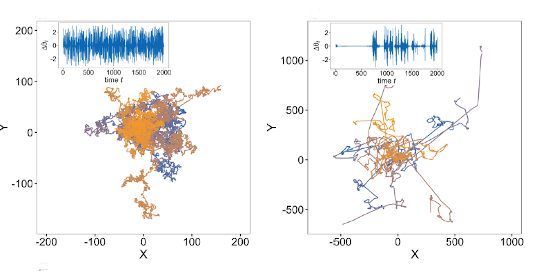A paper published in the Proceedings of the National Academy of Science (PNAS) explains the advantage that animals have of using a specific type of chaotic type of movement called a “Lévy walk,” and how this type of behavior emerges. Using computer modeling, the author shows that this type of movement can allow animals to make flexible decisions between “exploitation” and “exploring” in an environment.
“Lévy walks”—a type of behavior where an organism makes a mixture of small random-like movements and an occasional larger movement—are very common in biological systems. They are seen in the behavior of many animal species including humans, as well as in reptiles, fish, birds, and even individual cells. They are different from what is called a “Brownian walk”—which resembles the random movements of molecules in a gas or liquid, as the organism will occasionally take long movements which bring it to another location. However, the mechanisms through which these movements take place and the advantages they offer are not well understood.
To tackle this, Masato S. Abe of the RIKEN Center for Advanced Intelligence Project, the author of the paper, began by creating a mathematical model that imitate the motion of the lava of a fruit fly—a commonly used model organism—using two oscillators, which are connected together. When the link between the oscillators was very weak, the larvae basically followed random Brownian motion, and when they were tightly linked together, the larvae just walked in straight lines. When there was a weak linkage, however, they exhibited precisely what a Lévy walk would look like.
An interesting observation of the model was that Lévy walks emerged suddenly near points known as “critical points”—places where the behavior undergoes a rapid transformation. He wondered if this could be beneficial in some way, and found that in these areas, actors were able to respond strongly to even mild environmental stimuli, so it could help animals make finely tuned decisions over whether to exploit the food in one area or explore other areas. Abe then used observations of the actual movements of fruit fly larva to show that they were indeed carrying out behavior that fit with the model.
“Thanks to this model, we can now explain why Lévy walks, emerging near critical points in a system, make sense for organisms performing tasks such as foraging for food, as well as searching for words in their memory. This work will also help us in the field of artificial intelligence to create autonomous agents that can behave more closely like living organisms.”
Reference
Abe (2020). Functional advantages of Lévy walks emerging near a critical point. Proc. Natl. Acad. Sci. U.S.A., DOI:10.1073/pnas.2001548117
Contact
Postdoctoral Researcher
Masato S. Abe
Cognitive Behavioral Assistive Technology Team
RIKEN Center for Advanced Intelligence Project
Jens Wilkinson
RIKEN International Affairs Division
Tel: +81-(0)48-462-1225 / Fax: +81-(0)48-463-3687
Email: pr [at] riken.jp

A comparison of a Brownian walk (left) and Lévy walk (right)
Media Coverage
EurekAlert! (Sep.17) (Phys.org, Scienmag)




